|
Clark gave a talk about the notorious life of Al
Capone. Capone has ties to Lincoln and the Mill, as well as to some
of Logan County’s more colorful characters such as Coonhound Johnny,
who was a known bootlegger, and Ernie Edwards, who owned the Pig Hip
Restaurant in Broadwell.
The day began at 2:30 p.m. at the Mill for the presentation.
Afterward a caravan style motor tour was led by Geoff Ladd taking
guests to a wide variety of Route 66 attractions within the city of
Lincoln.
At approximately 5:15 p.m., tour guests finished their day at
Sorrento’s Pizzeria, where the special of the day was the Al Capone
Smoking Cannoli dinner for two.
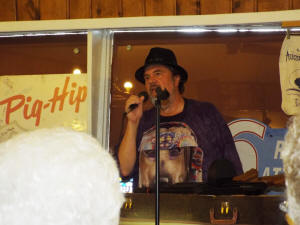
To start the day Ladd acknowledged some of the Mill
volunteers, the 90th Anniversary of the Mill and the upcoming 100th
Anniversary of Route 66 in 2026.
Ladd acknowledged that the guest speaker for the day had contributed
enough materials to the Mill that the Mill was able to establish a
Route 66 Library and was now on the “National Registry of Route 66
Libraries.” To that end, the library at the Mill has been named in
honor of Clark as the David G Clark Library.
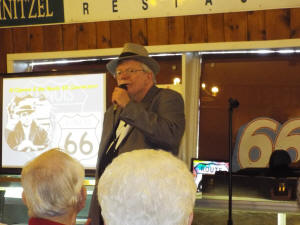
When Clark was called to the front to speak, he began
by acknowledging the recognition he was being given and went on to
say that his journey through the history of Al Capone and Route 66
had begun with his late wife, who had collected information on his
behalf over the years. He noted there were three pieces of Route 66
literature that started the journey and collection. In honor of his
wife, he would be donating those three items to the Mill for their
massive display of Route 66 items.
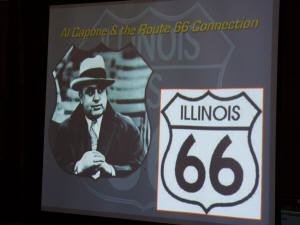
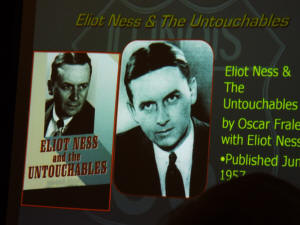
Clark then moved on to the topic of the day - Al
Capone and the prohibition era. He started by playing clips from the
popular gangster television and movies about the “untouchables.” In
those productions, he noted that the writers and directors had taken
artistic license with some of the details of the life and times of
Elliott Ness and Al Capone. He concluded though that the
sensationalism of the characters and events were acceptable because
neither the television shows nor the movie were designated as
documentaries. He used a particular scene in the movie as an example
where there is a stairway at Union Station and a shootout where a
baby carriage is careening down the stairs. One of Ness’s group
rescues the carriage while shooting a large number of bad guys.
Clark said in that particular scene the death toll is tremendously
high and had that been a true event, the number of people killed
would have exceeded the number killed in the Valentine’s Day
Massacre.
Another scene he disputed, Al Capone was being driven from the
courthouse after his sentencing for tax evasion. The scene included
Ness standing outside Capone’s transport looking into the car at
Capone. Clark said that at that particular time in history Ness was
not working on the Capone case. He said, yes, there was a
possibility that Ness was there as a spectator, but the idea that he
was there as the man who brought Capone down at that point in time
was incorrect.
Clark walked through the Chicago area connections between Capone and
Route 66 in the era of the battles over beer during prohibition.
There were more than sixty breweries in Chicago that were impacted,
and supposedly shut down, during prohibition. A number of those
breweries were located in areas along Route 66. He told how Chicago
mobsters had circumvented the law, continuing on in their
manufacture and sale of alcohol without being shut down. He told the
stories of “flunkies” who were hired to play the part of the brew
master or manager of a brewery. Their sole responsibility was to
occupy the manager office, while the real manager was disguised.
When the ‘feds’ would raid the place, the flunky was arrested and
hauled off for prosecution, while the real manager was able to
quickly re-establish business as usual.
[to top of second column] |
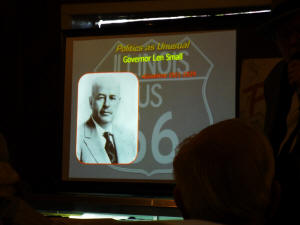
Clark talked about the history of Route 66 and how
that it was established through the work of a crooked governor Len
Small. Small bought votes with promises of paved roads. He was quite
successful and even though he was obviously crooked, well loved by
the people of the state who voted him in for two terms. The roads
were for the most part built, including the Route 4/Route 66
corridor from Chicago to St. Louis.
Clark also talked about the Capone connection to
Lincoln and said that Capone did visit the area and was the guest of
Coonhound Johnny. He recounted that Coonhound Johnny in turn
introduced Capone to Ernie Edwards, and would call on Edwards to
provide transportation for Capone when the gangster was visiting the
area. Ladd would later recount that Edwards once told him that the
most terrifying thing he ever did was to act as chauffer for Al
Capone.
Clark also recounted that the bullet-proof cars owned by Capone had
a criminal connection to Logan County in another way. As organized
crime grew in Chicago, being Al Capone became a danger all in its
own. After a particular event where one of Capone’s vehicles was
generously sprinkled with bullets injuring Capone’s driver, the
mobster decided he needed better protection in his cars.
First, he chose a particular style and color that matched the
vehicles of the Chicago Police Department. This would help him blend
in and be less conspicuous. Capone purchased four identical vehicles
and had all of them reinforced with steel in the doors to protect
the passengers and added bullet proof glass.
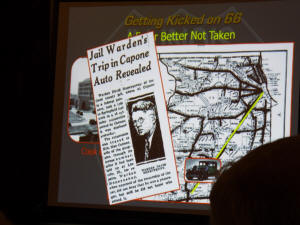
When Capone was arrested, he was taken into federal
custody, but was housed for a time at the Cook County Jail. While
there his car was impounded. On one particular day the jail warden,
David Montgomery, was in need of transportation to go from Chicago
to Springfield, passing through Lincoln. Montgomery chose to take
Capone’s vehicle out of impound and drive it to Springfield,
something that he should not have done. However, he would have
gotten by with taking the car had it not been that on the way back
to Chicago the car broke down in Lincoln. When questioned about the
incident, Montgomery did not deny taking the car, but did say he had
no idea who the car belonged to.
The armored cars owned by Capone also made national history. On
December 9th, 1941, it is reported that Secret Service Agent Michael
Reilly provided a Capone vehicle for then President Franklin D.
Roosevelt for added protection on the day following a declaration of
war against Japan.
The cars owned by Capone are also considered to be the first armored
cars in history.
Clark spoke about Capone for just over one hour accounting how the
man gained his power in Chicago and the many events during the
Capone era that established gangster or mob groups in Chicago.
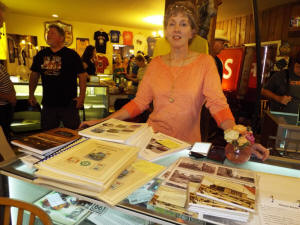
Many of those stories were connected to Route 66. At
the end of the discussion Clark offered up some of his books
including copies of ‘The roads that lead to Lincoln (the President)’
and ‘Exploring Route 66 in Chicagoland.’
Ladd invited guests to take some time visiting with Clark and also
visiting the museum. He announced that at 4 p.m. the motor tour
would begin outside the Mill and would conclude at Sorrento’s
Pizzeria from the Capone Special Dinner.
The number of people in attendance did fall a bit as the guests for
the motor tour gathered, but in all, about 15 people went on the
tour with Ladd.
[Nila Smith] |